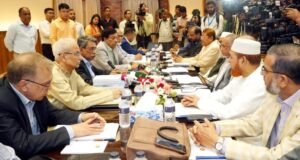 France and Germany believe the ceasefire in Ukraine is “generally” being observed, a statement from the French presidency says.
France and Germany believe the ceasefire in Ukraine is “generally” being observed, a statement from the French presidency says.
But the countries’ leaders, who helped broker the truce, said some “local incidents” must be “quickly” resolved.
Shelling has continued around the besieged town of Debaltseve.
However, fighting in the area is reported to have lowered in intensity since the ceasefire began at midnight Saturday (22:00 GMT).
Pro-Russian rebels had previously said they were entitled to fire in the town, as they believe the territory belongs to them.
Meanwhile, a military spokesman said Ukrainian troops had come under fire 60 times in the hours after the truce came into force,
The spokesman said Debaltseve continued to be the scene of most clashes.
The town – a key transport hub – has been the object of some of the fiercest fighting in the conflict zone in recent weeks, and the ongoing struggle there appears to pose the gravest threat to the truce.
The OSCE’s Michael Bociurkiw: “There has been an exchange of artillery fire and I believe that is ongoing”
OSCE monitors agree that the truce appears to be generally holding, but complain they have been denied access to Debaltseve.
In Sunday’s statement, the French presidency said leaders of the four countries that negotiated the truce last week – France, Germany, Ukraine and Russia – had held more talks on Sunday.
Germany’s Chancellor Angela Merkel and French President Francois Hollande spoke to Russian President Vladimir Putin and Ukrainian President Petro Poroshenko, agreeing to move towards implementing the next stage of the latest Minsk deal, the statement said.
According to the agreement, cessation of hostilities is only the first step and should be followed on day two of the ceasefire by the start of the withdrawal of heavy weapons to create two demilitarised buffer zones between 50-140km (30-85 miles) wide.
Analysts point out that previous ceasefires initially appeared to be holding but eventually failed, and say the next 48 hours are critical.
Officials say more than 5,400 people have been killed since the conflict erupted in eastern Ukraine in April, but the UN believes the actual death toll to be much higher.
In a televised address at the time the ceasefire took hold, President Poroshenko said Ukrainian troops in Debaltseve had been resupplied with ammunition.
The US, which has warned it could begin supplying arms to Ukraine if the peace initiative failed, claimed on Saturday it had evidence that the Russian military had deployed weaponry around Debaltseve – contrary to Moscow denials that it is playing any direct role in the conflict.
Ertugrul Apakan, head of the Organization for Security and Co-operation in Europe (OSCE) monitoring mission, said in a briefing that the ceasefire mainly held in the first 12 hours – with some exceptions including Debaltseve and Luhansk.
But, referring to the denial of access to Debaltseve, he called on rebels to allow safe entry to all areas for monitors.
On Sunday morning, Ukraine military spokesman Vladyslav Seleznyov said the truce was being “observed in general”.
Another spokesman, Anatoly Stelmakh, said Ukrainian forces had “repelled a few attacks” in Shyrokyne, near the strategic southern port city of Mariupol.
A rebel spokesman, Eduard Basurin, concurred that the truce was largely holding for the time being but complained that Ukrainian forces were continuing to shell Debaltseve.
Reports from the main rebel stronghold of Donetsk said the city had suddenly fallen silent, allowing residents in the city some precious respite from artillery bombardment.
But few residents expressed confidence that the truce would hold for longer than a few days.
European leaders have warned Russia that it could face additional sanctions if the 13-point Minsk ceasefire agreement is not respected.
 Weekly Bangla Mirror | Bangla Mirror, Bangladeshi news in UK, bangla mirror news
Weekly Bangla Mirror | Bangla Mirror, Bangladeshi news in UK, bangla mirror news






